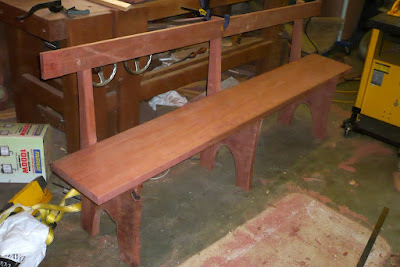As a follow up from my trip to Sturt I'd like to mention some of their courses. In addition to their 1 year Cert IV in Fine Furniture Making they also offer a series of evening courses, 12 week courses and weekend courses. Info for the weekend courses is listed below with a link to their site for more details.
2nd & 3rd April 2011 $260 including GST
Paul Nicholson is a furniture designer/maker and has been a member of the Splinter Workshop for 8 years. Paul is a graduate of the Sturt School for Wood and has a special interest in traditional wood working methods and the use of hand tools.
This course is designed for absolute beginners providing an introduction to woodwork by exposing participants to some basic methods including marking out, sawing, planning, paring (chiseling), assembling, sanding and finishing. The project is a serving tray with a dovetail joint at each corner and hand shaped handles. There will be some scope for personalisation if time permits.
Please bring with you writing materials, dust mask and wear closed shoes. An apron is optional. All working materials will be provided (wood, glue, finishing oil, rags, sand paper and disposable gloves). All tools will be provided but if you have any or all of the following please bring them (and please put your name on them): dove tail saw, small cross cut saw, marking knife, pencil, tri square, bevel gauge, block plane, rasp, small chisels (6-12mm), card scraper.
Making joints with Jim Littlefield
18th & 19th June 2011 $260 including GST
Jim Littlefield is a professional cabinetmaker of 35 years experience, teaching apprentice cabinetmakers for the past twenty and playing a large part in the restoration of the 100 foot steam yacht Ena in the 80s. At this time, Jim exhibited his work with the NSW Woodworkers’ Association, editing their newsletter as well as being technical editor of Australian Woodsmith magazine. Jim advocates the mastery of traditional hand skills and traditional construction as the foundation of good and satisfying cabinetmaking and joinery.
Learn to use sharp, quality hand tools to produce a range of traditional cabinetmaking joints that may include housing and rebate joints, tongue and groove joints, halving joints, mitre joints, mortise and tenon joints and dovetail joints. A small project such as an instrument case will be produced using some of these joints. Beginner and intermediate level.
Please bring with you writing materials, dust mask and wear closed shoes. An apron is optional.
The course fee is $260 (including GST). Payment and the completion of an enrolment form are essential to book a position. Enrolment forms are available at www.sturt.nsw.edu.au or from Sturt Gallery: 02 4860 2083. These courses will be held from 9.30 until 4.30 in Sturt part time wood workshop. Tea and coffee are provided. Students bring their own lunch or order lunch from Sturt Café.
Cnr Waverley Pde & Range Rd Mittagong NSW
Ph 02 4860 2083 www.sturt.nsw.edu.au


























































.png)